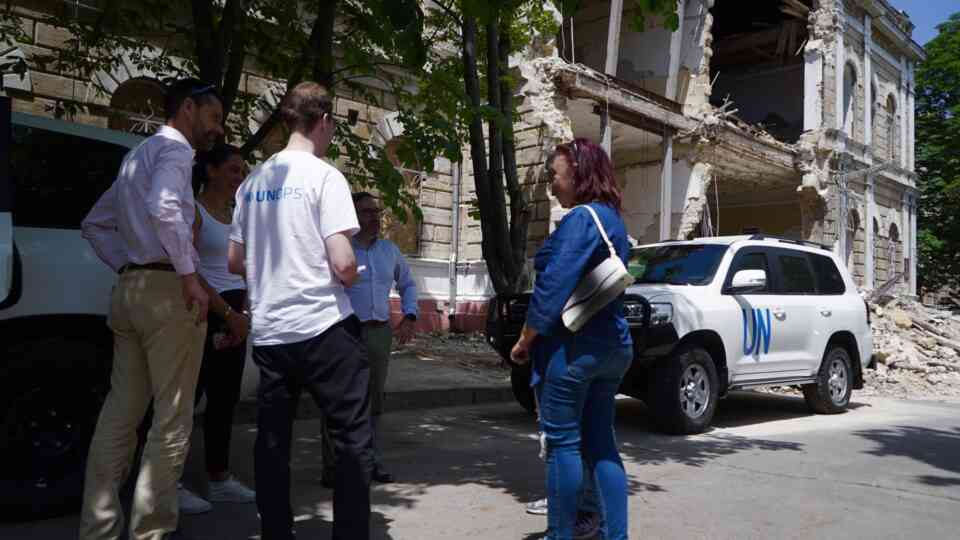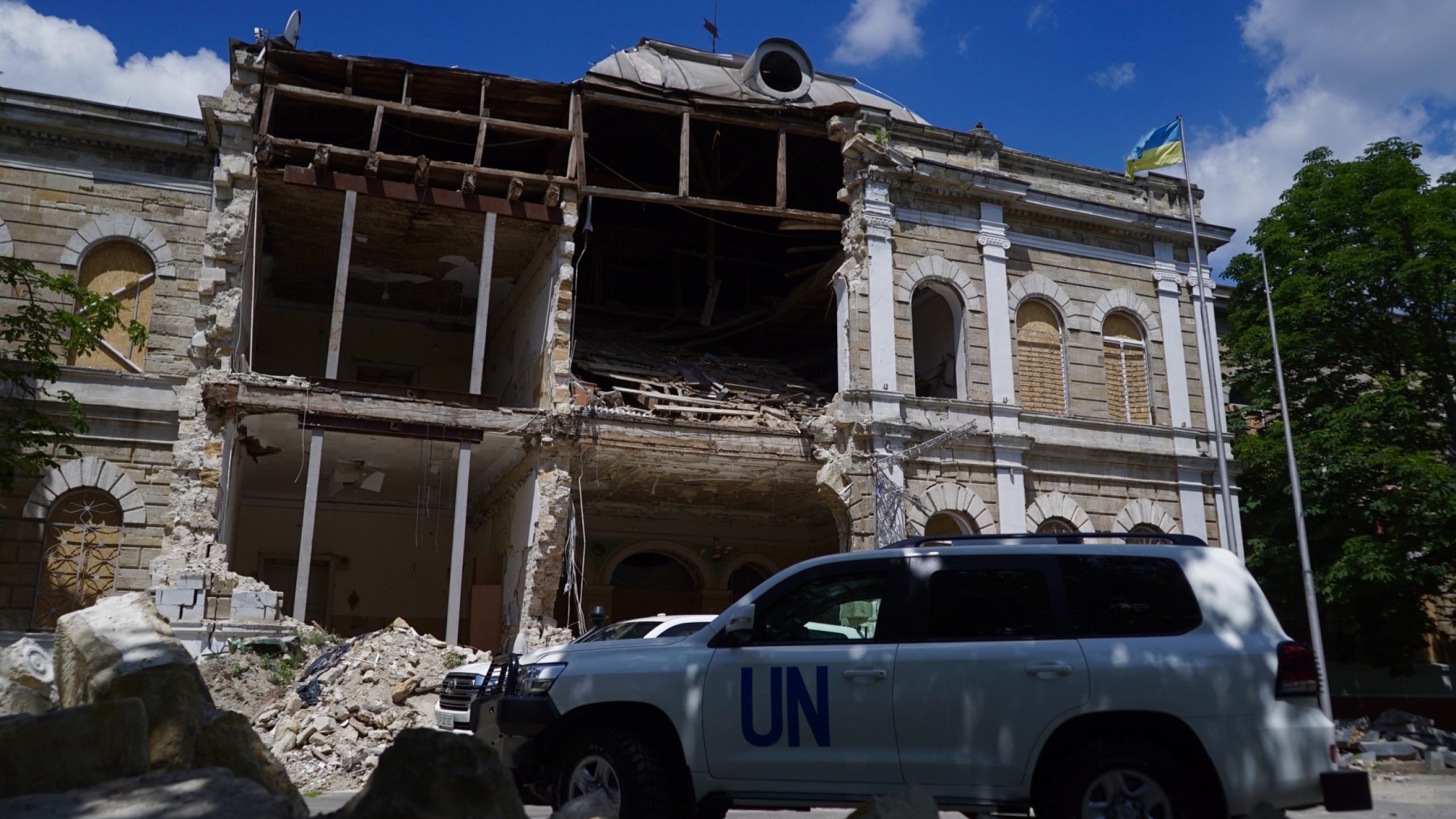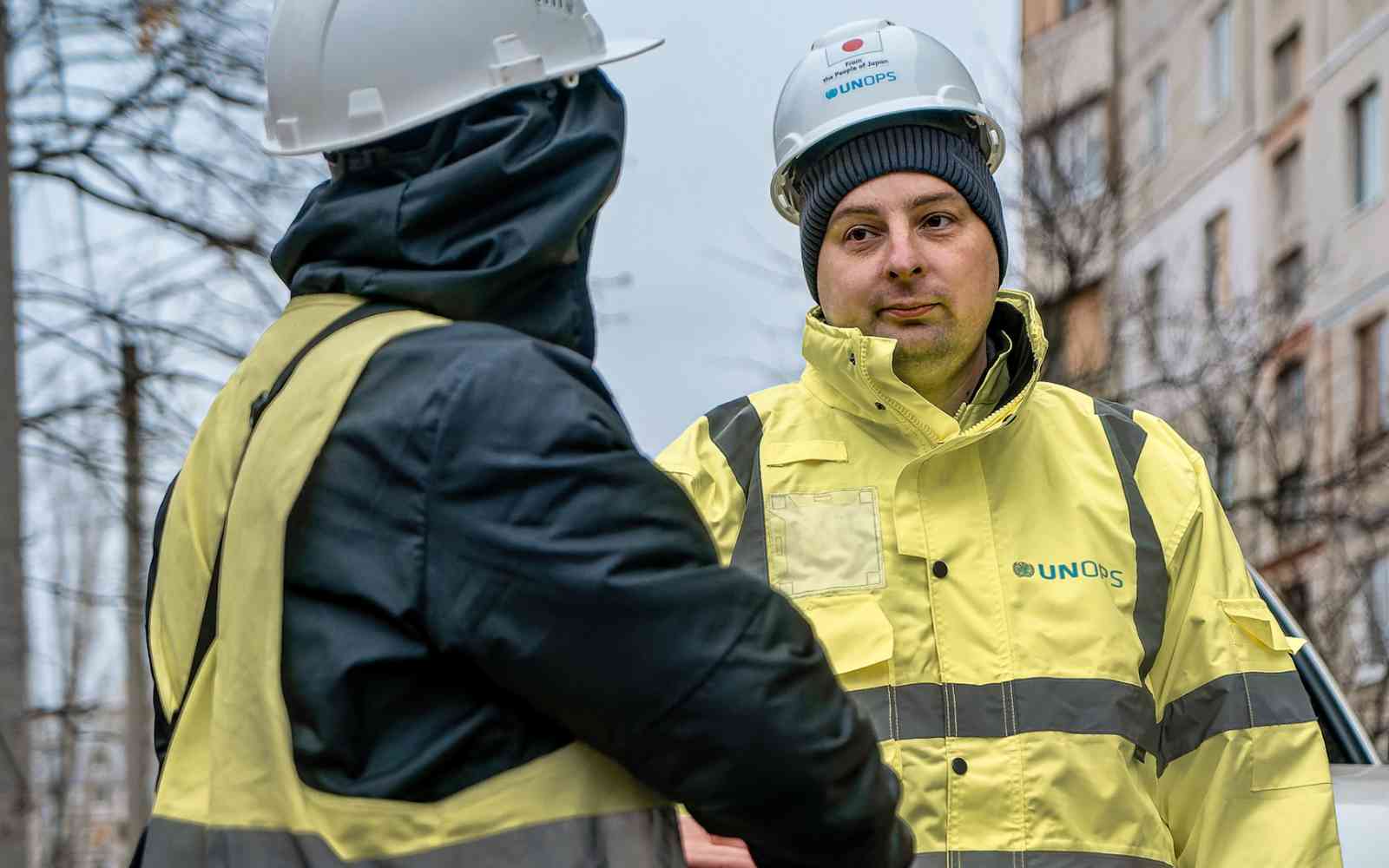The United Nations Office for Project Services (UNOPS)
Restoring entire communities in Mykolaiv
In the aftermath of the destruction caused by the ongoing war, UNOPS and the government of Denmark are working with local partners to rebuild and revitalize entire neighbourhoods in southern Ukraine.
Latest updates
October 2025
The underground shelters at schools in Horokhivske and Inhulka have been completed. With supervision from UNOPS engineers, previously derelict facilities have been turned into functional learning spaces, marking a step towards the resumption of in-class learning for several hundred children. The milestone was marked by a visit to the locations by Vitalii Kim, Head of the Mykolaiv Regional Administration, and Lars Olaf Søvndahl Petersen, Deputy Ambassador of Denmark to Ukraine.
Following community consultations, seven multi-apartment buildings in Mykolaiv City were selected for repairs, which were made possible by savings accumulated previously in the project. Work at these sites has commenced.
June 2025
UNOPS has completed restoration work on 19 residential buildings in the Zavodskyi district of Mykolaiv, helping around 400 households return to safer, more comfortable homes. As part of the upgrades, the project also improved nearby access roads and common areas, giving the neighbourhood a refreshed and more welcoming environment. This marks the completion of the original set of residential repairs planned under the project.
Thanks to careful planning and cost savings, UNOPS will now expand the project to include additional sites. Community consultations are currently under way to determine which locations will be included.
Work continues to stabilize the historic Arkas Lyceum in central Mykolaiv and to construct school shelters in the villages of Horokhivske, Inhulka and Kalynivka.
May 2025
Restoration work on 23 residential buildings in the Korabelnyi district of Mykolaiv has been completed. The repairs, which benefit 671 households, mark another milestone in the joint efforts of UNOPS and the government of Denmark to support long-term recovery for communities affected by the war. Work on residential buildings in other parts of Mykolaiv is also nearing completion.
UNOPS is also supporting the construction of school shelters in Horokhivske, Inhulka and Kalynivka villages in the Mykolaiv region. These shelters will help ensure safer learning environments and support the return to in-person education for children in these communities.
November 2024
UNOPS has signed a contract to repair roads in a residential neighborhood in Mykolaiv. These repairs will enhance accessibility, enabling emergency services to reach residential areas when needed.
September 2024
Repairs have begun on over 800 apartments across 43 residential buildings in three Mykolaiv neighborhoods. These improvements aim to create safer living conditions as winter approaches and help communities recover from damage inflicted during the war.
In central Mykolaiv, UNOPS has begun collaborating with a local contractor to stabilize the structure of the Arkas Lyceum. Using a safety-focused design developed by UNOPS, the contractor will implement a solution to prevent further damage to the building and ensure the safety of workers and the community.
August 2024
A new fire alarm and lightning protection system has been installed at the dormitory of Mykolaiv National Agrarian University. This essential upgrade will allow the safe return of approximately 600 students.
Repairs to two community recreational spaces in Mykolaiv City have been completed. These revitalized areas offer residents safe spaces to connect and engage, fostering stronger community bonds.
March 2024
UNOPS expanded the project to include installing a fire alarm and lightning protection system at a dormitory of Mykolaiv National Agrarian University. These systems are essential for the dormitory to safely reopen, allowing around 600 students to reside on campus and attend in-person classes.
February 2024
UNOPS completed a comprehensive damage assessment and feasibility study for Mykolaiv Shipbuilding University. This marks an important first step in restoring the university’s buildings.
October 2023
In collaboration with the government of Denmark, UNOPS expanded the project to include the structural stabilization of Arkas Lyceum, a historic high school and cultural landmark. Following damage from a missile strike in November 2022, the Lyceum requires stabilization to prevent further deterioration and prepare it for future restoration.
August 2023
After initial assessments and community consultations, the project was set to include:
Comprehensive improvements in three Mykolaiv neighborhoods, encompassing building repairs, recreational spaces, and access roads.
Installation of school shelters to enhance safety and support in-person learning across Mykolaiv and nearby areas.
A feasibility study and damage assessment for Mykolaiv Shipbuilding University, a key institution in southern Ukraine.
Mykolaiv City, like many others in Ukraine, has been deeply impacted by the war. According to a damage assessment by the EU, a total of 1,389 sites in Mykolaiv were damaged. The consequences of the destruction extend far beyond physical damages. The war has disrupted lives, fractured communities and undermined hopes of a prosperous future.
Funded by the government of Denmark, a UNOPS-implemented project will rebuild vital infrastructure and help rejuvenate communities in Mykolaiv.
The people of Ukraine have endured unimaginable difficulties. UNOPS is committed to the restoration and revitalization of communities in Mykolaiv and across the country.
“This is the latest partnership between UNOPS, Denmark and Ukraine, and it embodies our dedication to not only rebuilding infrastructure, but also fostering a renewed sense of hope and resilience among local communities. We are working in an inclusive manner to achieve a future where these communities recover from the challenges they've faced and thrive in the face of adversity,” explained Tim Lardner, UNOPS Ukraine Country Director.
The project will be delivered across three stages.
In close collaboration with the authorities of Mykolaiv City, UNOPS will conduct needs assessments within certain neighbourhoods in Mykolaiv. Experts will study options to restore critical services such as the water supply, sewage systems, roads, schools, hospitals, kindergartens and nurseries. Additionally, the project will create shelters in key locations to ensure the safety and resilience of the communities .
The project will then move into detailed damage assessments within the chosen neighbourhoods. This will guide the design of the reconstruction, in line with Ukrainian requirements. Local partners will be engaged to carry out the restoration work. Simultaneously, community mobilizers will work closely with residents, addressing concerns, prioritizing interventions, and identifying opportunities for local employment.
The final phase of the project will involve restoring selected infrastructure where needed and requested. The goal is to empower communities to regain control over their lives.




















